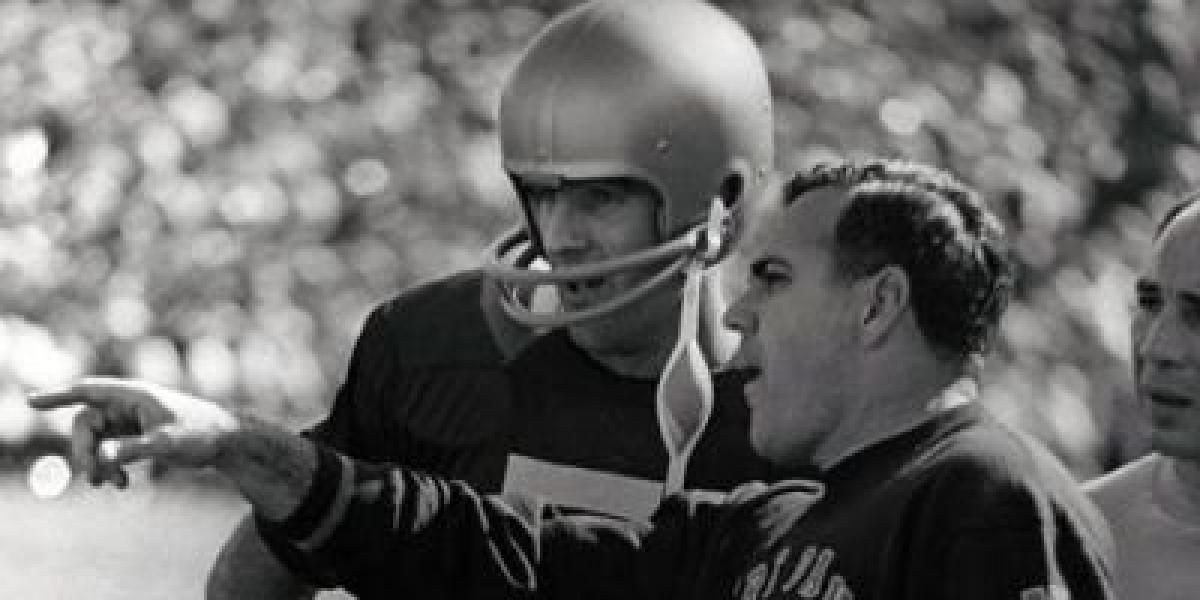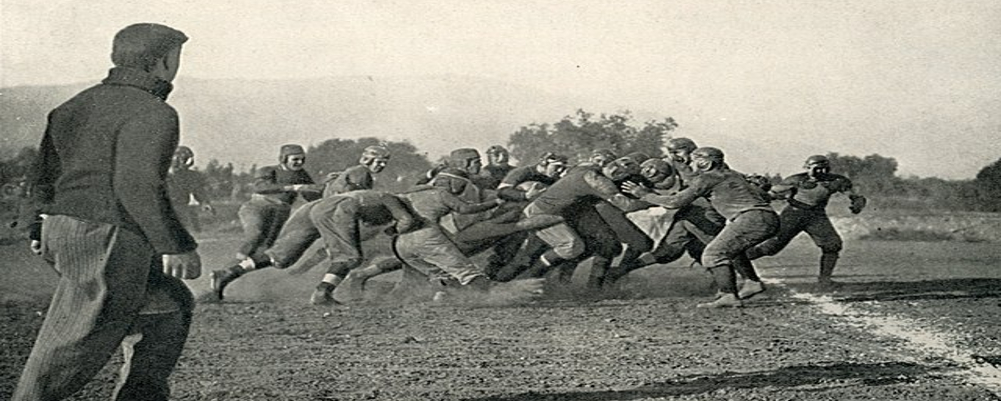Here is Tim's original Tidbit that the topic derived from, Coaching One Player During Timeouts
Transcription of One Coach with Timothy Brown
Hello, my football friends; this is Darin Hayes of PigSkinDispatch.com. Welcome once again to The Pig Pen, your portal to positive football history. We're going to look in that portal today and go back and do some football archaeological work with Timothy P. Brown of FootballArcheology.com. Tim, welcome back to The Pig Pen.
Darin, thank you. Looking forward to chatting once again.
Always fun to talk about old-time football. Yeah, and you have some real dandies that come out in the tidbits each and every day, and one that really caught my eye that I'd like to talk about tonight is you have, it's titled Coaching One Player, and I find this very interesting on multiple levels, and my officiating ears go up on this one because, you know, I can appreciate what the officials had to deal with during these times too. So I'll let you take the floor here and tell us all about this.
Well, I think I said this two weeks ago, but there are certain stories that need background in order for a more current story to make sense. Hey, we're here to hear old football stories, so the more we can hear, the better. Then you're going to benefit from that kind of idea and thinking today.
So this, for I think everybody, whether you've lived through this era or not if you're a football fan, you've seen images of a coach standing on the sideline talking typically to his quarterback. Sometimes, it could have been his mid linebacker, but most often, the pictures would show the quarterback. And so it's obviously a timeout, and so they're, you know, the two are conferring about game strategies and which plays to call, et cetera.
And so, but the odd thing is, why the heck is he just talking to his quarterback? Because nowadays the whole team comes over or, yeah, I mean, especially like high school, the old team will come running over coach and listen to coach jabber, you know, 35 seconds and then run back and execute a play. But so this whole thing of the coach being able to talk to one player at a time during a timeout all has this background in the idea of coaching from the sideline. And so that was illegal really until, you know, in the college game, it was illegal until the 1960s.
It was illegal in the pro game until 1944. But so it all has to do with this idea that, you know, originally the football teams were organized by the athletes themselves, just they were club teams, just like any, I don't quite want to make it sound like, you know, the club Quidditch team at some college or university today, but, you know, fundamentally, it's the same thing. A bunch of guys got together and said, hey, let's play football.
And so they organized themselves and then it got popular. So a lot of people wanted to attend and blah, blah, blah. So the game, you know, evolved, but it had this fundamental belief that the game was for the players, not for the fan, not for the coaches.
And so there's a whole slew of football rules and underlying beliefs that are aligned with that. And, you know, I mean, some of it's kind of hidden, but even things like, you know, numbering the players was for the fans, but it was opposed by the coaches for a long time. So that's why we didn't have numbers.
But so one of the things that was by tradition, you're supposed to engage the player's brawn and the brain. Therefore, coaches, fans, and spectators are not supposed to yell instructions to the players. And so that all worked and was, you know, the tradition and kind of the etiquette allowed that or made sure that didn't happen until the late 1880s.
And then people kind of started cheating a bit. And so they enacted a rule in 1892 that said, if somebody coaches from the sideline, it's a 15-yard penalty. And so if you think about other and older pictures that you've seen of football teams when you saw, you see pictures of all the players sitting on a bench on the sideline, you see pictures of all the players sitting or kneeling on the sideline, or you see one or two coaches standing.
And all of that was just at various times, the rules morphed a bit, especially in terms of the number of coaches that could stand on the sideline or move up and down during play. But the, you know, even when they could move around a bit, they still could not instruct the players. So there were things in the 19, I want to say it's the late 1930s, there were some experimental games where they had a 12th student, so a team member, maybe he was a smart guy, but he was like the third string quarter.
They put him out on the field to call the plays and instruct the team because he was a student, not a coach. So there were some experimental games, you know, trying that because, again, student, not a coach. So, even the rule that they had was the kicker; if there were times when they did allow teams, the kicker had to request the tee.
You couldn't, you know, some of the sidelines couldn't just toss a tee out onto the field; the kicker had to request it. Because if you just toss the tee out there, that meant the coach had said, I want them kicking, you know, I want them to try the field goal here from the 35-yard line or whatever. Anyway, there is a whole set of rules like that.
But then in, you know, say, 1940s, you have two platoon footballs coming along. That allowed coaches to coach the defense while they were off the field or the offense when they were off the field. And then eventually, in the 50s, you had, you know, in the pro level, anyways, they had what they called messenger guards, where teams would swap, they'd have guards run back and forth between days.
So that, you know, one, the right guard would swap between one guy and the other, and they would bring in the play each ball. Interestingly, a guy named Chuck Knoll was one of the first messenger guards to play and perform that function. So... I think I've heard of him before.
Yeah, I think he, well, I know the listeners can't see that, but you're wearing a Pittsburgh Steelers hat. So, I think you've heard of Chuck Knoll before. But so eventually, in 1967, they passed a rule that said, okay, now when we call a timeout, you know, previously, even during a timeout, the players, the coach could not talk to the players; they had to stay out there on the field.
And even with injuries, the coach could not go out there; just one person who was a medical professional could go out there. And so in 1967, in the colleges anyways, they said, one player can talk to a coach. And so that's why you see all those pictures.
And actually, the high schools had made that rule change a couple of years earlier. And then, you know, early 70s, maybe late 60s, somewhere in there, the high schools also just said, let's allow all 11 players to come over to the sideline to talk to the coach. So again, it's one of those goofy things, but it's grounded in this whole background, underlying people's belief systems about football.
But believe it or not, at the high school level, the phenomenon, you know, even through my officiating career, it's only the last 10 or 15 years that more than one coach can go out on the field and more than 11 players can be out there. When they had it for a long time that I officiated, you had to have only 11 players and one coach, and they had to be at least inside the nine-yard marks, which is the top of the numbers. And, and you had to call, you know, technically, if they did that, you're supposed to call it illegal substitution.
I mean, we just tried to enforce it and keep them back, but it was a pain in the neck because you know how timeouts are; it's sort of chaotic. And you're trying to tell these coaches, they can't, you know, the defensive assistant wants to come out with the head coach and whatever you got to chase them back. But they, they did a promotion.
Right. Right. So the national federation had to be like 10, 15 years ago, finally in this century said, Hey, you can have as many players and as many coaches come out anywhere on the field.
And as long, you know, but when that minute's up, you know, everybody's got to be out of there. And just the 11 players are on their own side of the ball. So it's still an evolving transition of that rule, at least at the high school level.
And it's much easier to do it now. I think, you know, you raised a really interesting point of view from the official, right? So, you know, I played, I coached. So I have that perspective on what it's like to do those things, but I never officiated.
And so I don't understand the game from that perspective, as well as the pressures and the concerns. Right. And so there's, there's just, I mean, there's a lot of things out there in the rules that, you know, even like the, the stripes, stripes on the gridiron, you know, the 10, the five-yard stripes, when there was a checkerboard, the checkerboard stripes, there are lots of things that were put on the field to help the officials, not to help the, you know, the players.
Like the game, they're playing behind me right now. Yeah, exactly. And, you know, the difference between whistles and horns and all that kind of stuff, the final gun, you know, there were so many things that, that really, you know, they were instituted to make officiating easier and, and more regulated, more consistent, you know, because what do people complain about? Inconsistent officiating, right? So, you know, there's a reason.
They still complain about that. If you watched the games in the playoffs this year and the regular season, you know, even us old officials complained about some of them, but it's. Yeah.
But, but it really, I mean, it really, you know, like your perspective just lends a different lens, a different way to look at the game. And, you know, so I just, I appreciate that. It's just, you know, I get it, but I don't get it.
Yeah. It's, it's, it's definitely something. I mean, I, I miss, I love being out on the field.
I love the people that I work with. I love, you know, the coaches and the kids, but there's some, some parts of it that I don't miss, especially when you have a, a coach that had a bad day and he's going to take it out on you because you're the easiest target for him. And you're a sideline official.
You know, those are always fun, but yeah, I like the game and ship. I love doing it and going back and forth with the coach, and that's part of the fun of it. And it's an exciting thing.
And it's part of the game. I have a quick little story I have to tell you. One of my favorite college memories is that I played at a small college, and we had a game with a backup quarterback who was just a kind of poster.
And at one point, you know, in the middle of a game, a referee threw a flag, and then the play ended up at about 20, 30 yards downfield. And so, but he had thrown his flag near the line of scrimmage. And so this quarterback goes out on the field, picks up the guy's flag, stuffs it in his pants.
And so the, the official comes running back, you know, he's a headlinesman or whatever, cause he's right along the side. He comes back, and he can't find his flag. And so our coach starts yelling at him like, what are you doing? You know, you're delaying the game, you know, sticks.
So then the guy heads back upfield, looking for his flag, and when the quarterback takes the flag and dumps it back on the field, where, you know, it is behind him. And then the official turns around, sees the flag sitting there, and knows that it wasn't there like five seconds ago. He just, he just smiled, and he didn't say a damn thing.
He knew one of the kids was in his chain. And I just think I recall that it's just one of my favorite memories in college. It was just like a small college.
It really didn't matter, but it mattered. And so for somebody to think about, to think that quickly to do, to pull off that trick, and for the official to just let it go, I thought it was just total class. Cause he could have he could have flagged somebody.
Right. But it seems like you'd have it like every, every season, at least once or twice, you'd have that, that kid that just wants to help you out. You know, they, they, they're, they're just that helpful soul, and you throw a flag, and it's a spot foul.
And if the flag means something, you know, it wasn't like, you know, offsides or something, it's a holding or, you know, intentional grounding where the flag really matters, and you throw it, and you're, you know, you're, you're, that's why you have a flag. You're marking that spot, and you're following the rest of the play. And you, like you said, you might end up 30 yards downfield or 80 yards downfield, and you got to come back to the spot, but I'd always be turning around to come back.
And there's this kid, I can see him pick up the flag and say, I'll bring your flag to you, Mr. No, no, no, don't, don't do that. Thank you. But thank you.
But no, thanks. Yes. But yeah, that's all you always run into that kind of stuff, too.
But my teammate didn't have the official best interest at heart. Yeah. I think that was a little bit more malicious.
Are you sure this was a teammate, and it wasn't the person telling the story? No, it wasn't me. You seem to really have a lot of firsthand knowledge here. I've done, I've done, I was kind of a trickster, you know, sort of person.
So I've done things like that, but no, I, I, I didn't have the guts to do that. Yeah, that would be; it took a little bit of moxie to do that. I'm sure, especially with everybody in a stand, seeing what you're doing.
So, hey, Tim, great stuff as always, you know, this coaching and quarterback relationship and coaching with the, from the sidelines is always an interesting subject. And it's amazing how much that's evolved over the years and how much the perception of what the coach should be doing on the field and what he shouldn't be doing has changed over the last hundred years. It's just great stuff.
And I really like how you portrayed that out here in a story and this podcast tonight. And you know, you have these thoughts and these tidbits that come out each and every day on your website, social media, and email, and maybe you could share with the listeners how they could enjoy some of these, too. Yeah, so it's really easy.
My site is footballarchaeology.com. And as long as you spell it right, you'll find it. And so you can, there's, you know, every story that's out there, there's a subscribe button. And if you subscribe, you get get the email at seven o'clock Eastern every day, which comes right to your inbox.
And then alternatively, you can just follow me on Twitter at Football Archaeology. And then, you know, obviously, you can just go find it and, you know, periodically search it and see, see what's been published. But you know, from my perspective, the best thing for me is if you get the thing every day and, you know, if you've got a busy week, let them pile up.
And then when you got a little bit of time over the weekend, scan through them and see what interests you. All right. I, I'm glad that you, you mentioned that, that I'm not the only one that has trouble spelling archaeology every time I write it out.
And even if I spell it right, I look at it, and I, is that right? That's just one of those words that just doesn't look right, but hey. A-R-C-H-A-E-O-L-O-G-Y. Yeah.
I think maybe, maybe as an American, we pronounce it with that archaeology and A just doesn't seem like it belongs there, but hey, hey, great stuff and spell it right and put the dot com on the end and you'll get to Tim's site. And Tim, we'll talk to you again next week. Hey, very good.
Thanks, Darin.
Transcribed by TurboScribe.ai.




